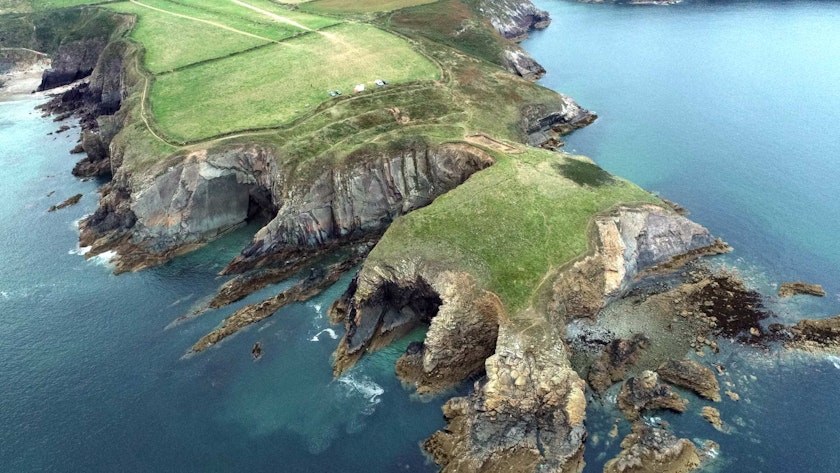
Hannah Genders Boyd introduces the cross-disciplinary CHERISH project, aiming to raise awareness and understanding of the impacts of climate change on the rich cultural heritage of the coasts of Wales and Ireland.

As we all know, the global climate is changing. Global temperatures have risen by more than 1˚C since 1850, which has had noticeable impacts on our planet. Glaciers are melting quickly, and average sea levels have risen 16 cm between 1902 and 2015.
In the UK and Ireland, we expect to experience warmer, wetter winters and hotter, drier summers. Extreme weather events, such as intense rainfall, droughts and storms, may happen more often.
These predicted changes will have a variety of effects on our coastal heritage, including coastal erosion and damage to buildings from increased storm surges, flooding and landslides during periods of higher rainfall, and increased risk of destabilisation and collapse of dried out cliff faces during our hotter, drier summers.
Climate projections and coastal heritage
Predicted climate change will have a variety of effects on our coastal heritage, including:
- Warmer global temperatures will lead to rising sea levels, impacting all aspects of coastal heritage as a result of flooding and storm surges.
- A rise in sea temperature bringing new marine species and pests affecting underwater and intertidal heritage.
- Hotter, drier summers may lead to the drying out of cliff faces increasing the risk of destabilisation and collapse affecting heritage sites on the coast.
However, they could also lead to the discovery of new heritage sites visible as parchmarks and cropmarks.
- Warmer, wetter winters could lead to the ground becoming saturated, increasing the risk of flooding, landslides and erosion at heritage sites.
- More frequent extreme weather could create turbulent seas damaging heritage on the seabed and foreshore; cause erosion and loss at the coast edge from wave action; and cause structural damage to buildings.
The CHERISH project
This summer, a travelling exhibition at CAT will highlight these issues and impacts, exploring the work of CHERISH, a six-year EU-funded project that aims to raise awareness and understanding of the past, present and near-future impacts of climate change on the coastal heritage of Wales and Ireland.
CHERISH is an acronym that stands for ‘climate, heritage and environments of reefs, islands and headlands’. The cross-disciplinary project brings together the Royal Commission on the Ancient and Historical Monuments of Wales; the Discovery Programme, Ireland; Aberystwyth University: Department of Geography and Earth Sciences; and Geological Survey Ireland, and was made possible thanks to €4.9 million of EU funding through the Ireland Wales Co-operation Programme. The project began in January 2017 and will run until June 2023.
New insight into our past and future
CHERISH links land and sea, employing a variety of techniques and methods to study some of the most iconic coastal locations in Ireland and Wales. These techniques range from terrestrial and aerial laser scanning, geophysical survey and seabed mapping, through to paleoenvironmental sampling, excavation and shipwreck monitoring.
Data produced by the project has given us a new understanding of how climate change is affecting specific sites on the coasts of Wales and Ireland. For example, a key driving factor behind the coastal erosion seen at Dinas Dinlle hillfort in Gwynedd is increased precipitation (see box overleaf), while increased storminess and increasing numbers of extreme weather events is the biggest risk to Dunbeg fort in County Kerry.
Understanding how climate change is affecting these sites, and creating baseline data for future monitoring, is important for knowing how to manage our heritage. We need to know what information is being lost, and how long different sites have left. Recording sites, for example through laser scanning or photogrammetry, creates a record that can be used by future researchers. This is particularly important if catastrophic loss occurs at a site, which may happen during an extreme weather event.
Retaining archaeological information is an important aspect of our collective response to the climate crisis. As we move into an uncertain future, where our society will face new and unforeseen challenges. Climate Heritage is an intersectional discipline including archaeologists, geographers, climate scientists and archivists. It has been described as “packing a cultural suitcase”: in the face of change and destruction, what do we save? This is not about protecting sites using hefty physical interventions – it’s about gathering knowledge while we have the opportunity, and employing that knowledge effectively.

Palaeoenvironmental research
Another important aspect of the CHERISH research has been gaining a long-term perspective on climatic change using palaeoenvironmental research.
Information on the nature, timing and rates of past environmental change provides a valuable long-term perspective for understanding current and future impacts of climate change. Physical, chemical and biological analysis of sedimentary archives help us to build up a picture of both regional climatic variability and local environmental change.
An important aspect of palaeoenvironmental research is the ability to accurately determine the timing of climatic or environmental change in a sediment record, or the age of an artefact or archaeological feature. CHERISH routinely employs two different techniques to provide the dating framework for sedimentary sequences and archaeological investigations:
radiocarbon dating and luminescence dating. The combination of these approaches means that we can date a greater variety of sample types and contexts. Where both techniques can be used, this provides a valuable opportunity for cross-validation of age estimates.
The CHERISH project is focusing on sediment sequences that have the potential to provide records of past storm activity, extending back over thousands of years, such as coastal peat bogs, backbarrier lagoons and dune systems. These have been sampled by taking cores at research sites in both Wales and Ireland.
Understanding the dates for past storm events, sea level changes, ecosystem changes, growth of woodlands or peatlands, settlement growth or abandonment, and other dynamic elements of a landscape, allows us to build up a picture of human-environment interactions through time. Adapting the environment, and adapting to environmental change, have been part of the experience of coastal communities for many thousands of years. As we move into a future of rapid change, how do we continue to respond and adapt? What lessons for the future are buried on our vulnerable coastlines?
The exhibition
The CHERISH exhibition can be seen at CAT from 9 May until 18 June 2023. On display will be visual data from the project, including lidar imagery, laser scan data and drone photography. The exhibition also features the way CHERISH has used art to communicate its science; there is Welsh-language poetry, inspired from our research sites, by poet and geographer Hywel Griffiths, and art from Mid Wales-based artists Julian Ruddock and Pete Monaghan, who have both been interpreting the scientific findings in their own unique way to create dramatic and thought-provoking works.
About the author
Hannah Genders Boyd is an archaeologist and Climate Heritage professional with a background in palaeoenvironmental research. She joined the CHERISH team in 2022 to work
with the datasets collected over the first five years of the project. Her role focuses on survey, data processing, public engagement and outreach.
http://cherishproject.eu/

- Gardening and Agriculture
- News Feed
Related Topics
Related Pages
EMAIL SIGN UP
Keep up to date with all the latest activities, events and online resources by signing up to our emails and following us on social media. And if you'd like to get involved and support our work, we'd love to welcome you as a CAT member.
